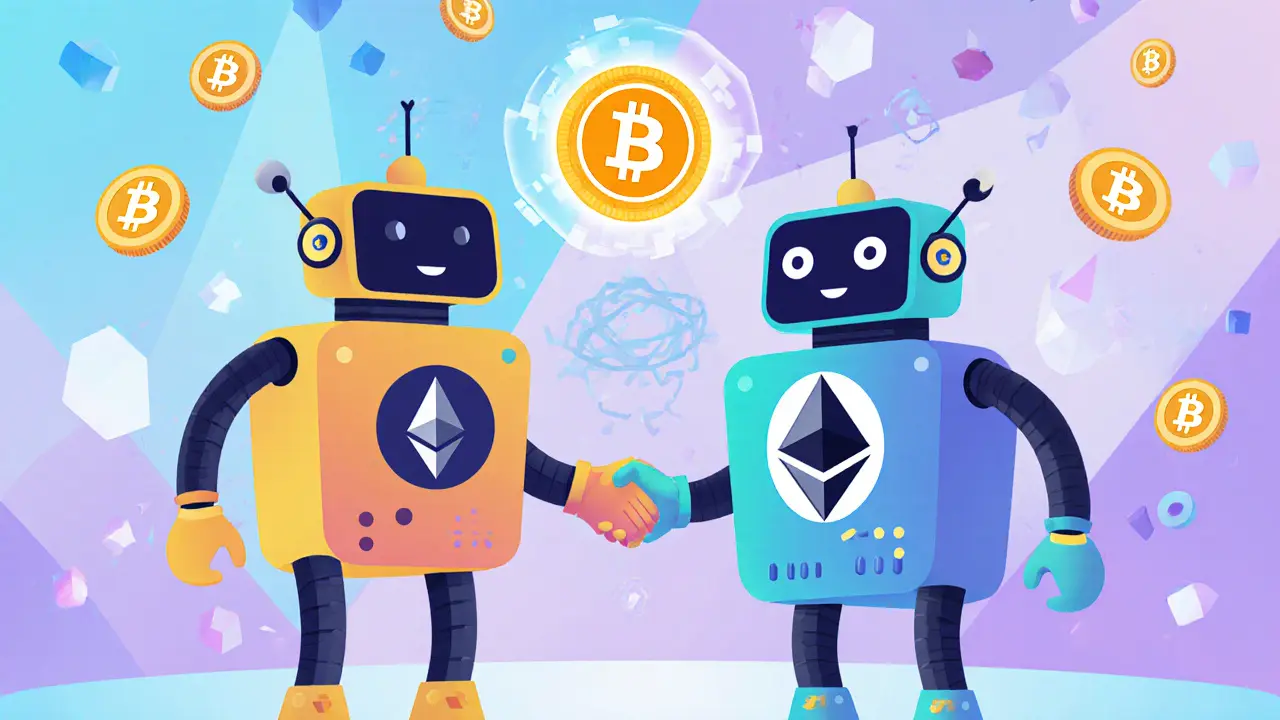How Blockchains Communicate with Each Other
 Nov, 10 2025
Nov, 10 2025
Imagine you have money in Bitcoin, but you want to use it to borrow funds on a DeFi platform built on Ethereum. Or maybe you own an NFT on Solana and want to trade it for a token on Polygon. Without blockchain interoperability, you’d need to sell your asset, move it through a centralized exchange, buy the new asset, and hope nothing goes wrong. It’s slow, expensive, and risky. But what if blockchains could talk to each other directly-like phones on different networks sending texts? That’s exactly what cross-chain communication does.
Why Blockchains Need to Talk
Most blockchains were built in isolation. Bitcoin handles payments. Ethereum runs smart contracts. Solana moves fast. But they don’t understand each other. This creates a fragmented digital economy. You can’t use your Bitcoin as collateral on a lending app that only accepts Ethereum tokens. You can’t move your NFTs between marketplaces without going through a middleman. That’s not just inconvenient-it limits innovation. Interoperability fixes this. It lets blockchains exchange data and value without trusted third parties. Think of it like the internet before HTTP. Early networks couldn’t talk. Then came protocols that standardized communication. Blockchain interoperability is the HTTP of Web3.How IBC Makes Blockchains Connect
One of the most reliable ways blockchains communicate is through the Inter-Blockchain Communication (IBC) protocol. It’s used by Cosmos, Juno, and other chains that want to stay decentralized while connecting. IBC doesn’t rely on bridges that lock up assets. Instead, it uses light clients-tiny programs that verify data from other chains without trusting them. Here’s how it works in simple terms:- A user on Chain A wants to send tokens to Chain B.
- Chain A packages the transaction into a data packet with sender, receiver, and amount info.
- This packet is sent to a hub (like a relay station) that connects multiple chains.
- The hub checks the packet using IBC’s Light Client, which confirms Chain A’s data is valid.
- The hub forwards the packet to Chain B.
- Chain B verifies the packet using its own Light Client for Chain A.
- Once verified, Chain B credits the receiver.
- OpenInit: Chain A says, “I want to talk to Chain B.”
- OpenTry: Chain B checks Chain A’s identity using its Light Client.
- OpenAck: Chain A confirms Chain B’s identity.
- OpenConfirm: Connection is live. Channels open for data.
Chainlink’s CCIP: A Security-First Approach
Not all chains use IBC. Many, especially Ethereum-based ones, rely on Chainlink’s Cross-Chain Interoperability Protocol (CCIP). Where IBC is peer-to-peer, CCIP is oracle-based. It uses a network of decentralized nodes to verify and relay messages between chains. CCIP was built because cross-chain hacks have cost over $1.2 billion since 2020. Most of those losses came from centralized bridges that got hacked. CCIP avoids that by design. Here’s how it works:- A user or dApp triggers a cross-chain transfer using the
ccipSendfunction. - Chainlink oracles collect the message and sign it using a threshold of 2/3 nodes.
- The message is sent to a router contract on the destination chain.
- That contract checks the signatures and executes the action-like minting tokens or calling a smart contract.
- Direct user send: Anyone can call
ccipSendto move assets. - Sender contracts: dApps use these to automate transfers, like paying fees or triggering actions.
- Token pools: Assets are locked in smart contract pools on each chain, so transfers are always backed.
What You Can Do With Cross-Chain Communication
This isn’t theoretical. People are already using it. - You can use your Bitcoin (via wrapped tokens) to get a loan on a DeFi platform like Aave on Ethereum. - You can trade a Solana NFT for a Polygon-based token in one click, without leaving your wallet. - A gaming platform on Arbitrum can verify ownership of a Binance Chain item to unlock special in-game gear. The real power? Combining strengths. Bitcoin’s security + Ethereum’s smart contracts + Solana’s speed. That’s the future.Challenges and Risks
It’s not perfect. Interoperability is still young. Complex systems mean more attack surfaces. A flaw in a Light Client, a misconfigured router, or a bad oracle signature can lead to loss. IBC requires each chain to implement its own Light Client. That’s hard. Not every chain has the engineering team for it. CCIP depends on oracle reliability. If the oracle network is centralized in practice, it defeats the purpose. Also, there’s no universal standard yet. IBC works great for Cosmos chains. CCIP is strong on Ethereum. But what if you want to connect a Bitcoin sidechain to a Solana app? That’s still messy. Developers are working on it, but we’re not there yet.
The Bigger Picture
Blockchain interoperability is the missing link in Web3. Without it, we’re stuck with siloed networks. With it, we get a true decentralized internet-where value flows like information does today. The goal isn’t to replace one chain with another. It’s to let them work together. Bitcoin stays secure. Ethereum stays programmable. Solana stays fast. And users? They get freedom. As more chains adopt IBC, CCIP, or similar protocols, the number of cross-chain dApps will explode. We’ll see decentralized exchanges that pull liquidity from five chains at once. Lending platforms that accept collateral from any network. Wallets that manage assets across ten different ledgers without switching. This isn’t science fiction. It’s happening now.What’s Next?
The next wave of interoperability will focus on:- Universal standards that work across consensus types (PoW, PoS, PoH, etc.)
- Lighter, more efficient Light Clients for low-resource chains
- Automated security audits for cross-chain contracts
- Wallets that handle cross-chain routing invisibly
Can Bitcoin communicate directly with Ethereum?
Not natively. Bitcoin’s design doesn’t support smart contracts or Light Clients needed for IBC. But wrapped Bitcoin (wBTC or WBTC) lets Ethereum apps use Bitcoin’s value by locking it in a custodial or decentralized vault. Newer projects like Bitcoin L2s (e.g., Stacks or LayerZero) are working on direct communication, but they’re still experimental.
Are cross-chain bridges safe?
Most centralized bridges have been hacked. They rely on trusted operators holding your funds. IBC and CCIP are safer because they don’t hold your assets-they verify and relay. IBC uses on-chain Light Clients; CCIP uses decentralized oracles. Still, no system is perfect. Always check if a bridge is audited, uses multiple oracles, and has a clear recovery plan.
What’s the difference between IBC and CCIP?
IBC is peer-to-peer and chain-native. It requires each chain to run its own Light Client. It’s used mostly in Cosmos and similar ecosystems. CCIP is oracle-based and works across any chain, especially Ethereum-compatible ones. It doesn’t need Light Clients-it uses decentralized nodes to verify messages. IBC is more decentralized; CCIP is more flexible and easier to integrate.
Do I need to know how these protocols work to use them?
No. Most users interact with cross-chain tools through wallets like MetaMask or Phantom. When you click “Swap” and choose a token on another chain, the app handles IBC or CCIP behind the scenes. You just send and receive. But understanding how it works helps you choose safer tools and avoid scams.
Can blockchains with different consensus mechanisms communicate?
Yes, but it’s harder. IBC requires chains to support Light Clients, which is easier for PoS chains. CCIP works across PoW, PoS, and others because it uses oracles, not chain-specific verification. Newer protocols are being built to handle this, like LayerZero and Axelar, which abstract away consensus differences so any chain can talk to any other.
Will interoperability make blockchains obsolete?
No. It makes them stronger. Chains will still specialize-Bitcoin for security, Ethereum for smart contracts, Solana for speed. Interoperability lets them complement each other. Think of it like highways connecting cities. The cities don’t disappear-they just become more useful together.
Sky Sky Report blog
November 22, 2025 AT 10:48IBC’s light clients are elegant. No custodians. No single points of failure. Just math doing the work.
stuart white
November 23, 2025 AT 16:21Jenny Charland
November 25, 2025 AT 00:32preet kaur
November 26, 2025 AT 04:04Amanda Cheyne
November 26, 2025 AT 14:35Omkar Rane
November 27, 2025 AT 15:23Daryl Chew
November 28, 2025 AT 11:23